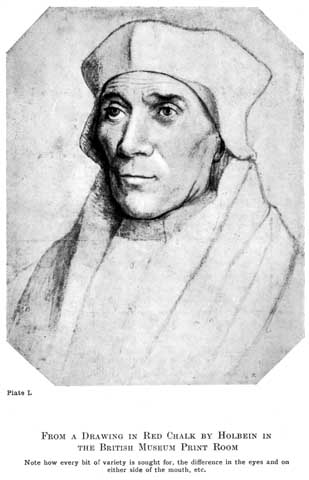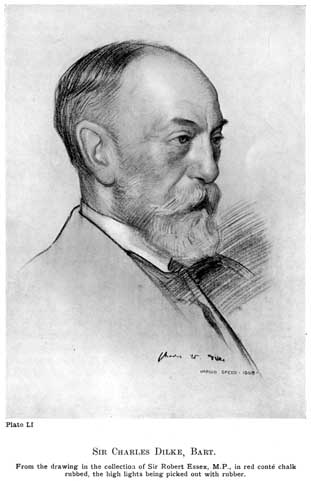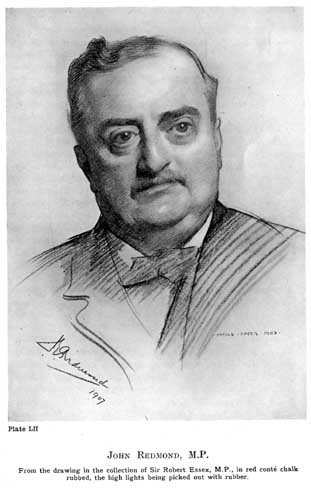This character expression in form has been thought to be somewhat antagonistic to beauty, and many sitters are shy of the particular characteristics of their own features. The fashionable photographer, knowing this, carefully stipples out of his negative any striking characteristics in the form of his sitter the negative may show. But judging by the result, it is doubtful whether any beauty has been gained, and certain that interest and vitality have been lost in the process. Whatever may be the nature of beauty, it is obvious that what makes one object more beautiful than another 240is something that is characteristic of the appearance of the one and not of the other: so that some close study of individual characteristics must be the aim of the artist who would seek to express beauty, as well as the artist who seeks the expression of character and professes no interest in beauty.
Catching the likeness, as it is called, is simply seizing on the essential things that belong only to a particular individual and differentiate that individual from others, and expressing them in a forceful manner. There are certain things that are common to the whole species, likeness to a common type; the individual likeness is not in this direction but at the opposite pole to it.
It is one of the most remarkable things connected with the amazing subtlety of appreciation possessed by the human eye, that of the millions of heads in the world, and probably of all that have ever existed in the world, no two look exactly alike. When one considers how alike they are, and how very restricted is the range of difference between them, is it not remarkable how quickly the eye recognises one person from another? It is more remarkable still how one sometimes recognises a friend not seen for many years, and whose appearance has changed considerably in the meantime. And this likeness that we recognise is not so much as is generally thought a matter of the individual features. If one sees the eye alone, the remainder of the face being covered, it is almost impossible to recognise even a well-known friend, or tell whether the expression is that of laughing or crying. And again, how difficult it is to recognise anybody when the eyes are masked and only the lower part of the face visible.

Plate L.
FROM A DRAWING IN RED CHALK BY HOLBEIN IN THE BRITISH MUSEUM PRINT ROOM
Note how every bit of variety is sought for, the difference in the eyes and on either side of the mouth, etc.
241If you try and recall a well-known head it will not be the shape of the features that will be recollected so much as an impression, the result of all these combined, a sort of chord of which the features will be but the component elements. It is the relation of the different parts to this chord, this impression of the personality of a head, that is the all-important thing in what is popularly called "catching the likeness." In drawing a portrait the mind must be centred on this, and all the individual parts drawn in relation to it. The moment the eye gets interested solely in some individual part and forgets the consideration of its relationship to this whole impression, the likeness suffers.
Where there is so much that is similar in heads, it is obvious that what differences there are must be searched out and seized upon forcefully, if the individuality of the head is to be made telling. The drawing of portraits should therefore be approached from the direction of these differences; that is to say, the things in general disposition and proportion in which your subject differs from a common type, should be first sought for, the things common to all heads being left to take care of themselves for a bit. The reason for this is that the eye, when fresh, sees these differences much more readily than after it has been working for some time. The tendency of a tired eye is to see less differentiation, and to hark back to a dull uniformity; so get in touch at once with the vital differences while your eye is fresh and your vision keen.
Look out first for the character of the disposition of the features, note the proportions down an imagined centre line, of the brows, the base of the nose, the mouth and chin, and get the character 242of the shape of the enclosing line of the face blocked out in square lines. The great importance of getting these proportions right early cannot be over-emphasised, as any mistake may later on necessitate completely shifting a carefully drawn feature. And the importance of this may be judged from the fact that you recognise a head a long way off, before anything but the general disposition of the masses surrounding the features can be seen. The shape of the skull, too, is another thing of which to get an early idea, and its relation to the face should be carefully noted. But it is impossible to lay down hard and fast rules for these things.
Some artists begin in point drawing with the eyes, and some leave the eyes until the very last. Some draughtsmen are never happy until they have an eye to adjust the head round, treating it as the centre of interest and drawing the parts relatively to it. While others say, with some truth, that there is a mesmeric effect produced when the eye is drawn that blinds one to the cold-blooded technical consideration of a head as line and tone in certain relationships; that it is as well to postpone until the last that moment when the shapes and tones that represent form in your drawing shall be lit up by the introduction of the eye to the look of a live person. One is freer to consider the accuracy of one's form before this disturbing influence is introduced. And there is a good deal to be said for this.
Although in point drawing you can, without serious effect, begin at any part that interests you, in setting out a painting I think there can be no two opinions as to the right way to go about it. The character of the general disposition of the 243masses must be first constructed. And if this general blocking in has been well done, the character of the sitter will be apparent from the first even in this early stage; and you will be able to judge of the accuracy of your blocking out by whether or not it does suggest the original. If it does not, correct it before going any further, working, as it were, from the general impression of the masses of the head as seen a long way off, adding more and more detail, and gradually bringing the impression nearer, until the completed head is arrived at, thus getting in touch from the very first with the likeness which should dominate the work all along.

Plate LI.
SIR CHARLES DILKE, BART.
From the drawing in the collection of Sir Robert Essex, M.P., in red conté chalk rubbed, the high lights being picked out with rubber.
There are many points of view from which a portrait can be drawn—I mean, mental points of view. And, as in a biography, the value of the work will depend on the insight and distinction of the author or artist. The valet of a great man might write a biography of his master that could be quite true to his point of view; but, assuming him to be an average valet, it would not be a great work. I believe the gardener of Darwin when asked how his master was, said, "Not at all well. You see, he moons about all day. I've seen him staring at a flower for five or ten minutes at a time. Now, if he had some work to do, he would be much better." A really great biography cannot be written except by a man who can comprehend his subject and take a wide view of his position among men, sorting what is trivial from what is essential, what is common to all men from what is particular to the subject of his work. And it is very much the same in portraiture. It is only the painter who possesses the intuitive faculty for seizing on the significant things in the form expression of his subject, of 244disentangling what is trivial from what is important; and who can convey this forcibly to the beholder on his canvas, more forcibly than a casual sight of the real person could do—it is only this painter who can hope to paint a really fine portrait.
It is true, the honest and sincere expression of any painter will be of some interest, just as the biography written by Darwin's gardener might be; but there is a vast difference between this point of view and that of the man who thoroughly comprehends his subject.
Not that it is necessary for the artist to grasp the mind of his sitter, although that is no disadvantage. But this is not his point of view, his business is with the effect of this inner man on his outward appearance. And it is necessary for him to have that intuitive power that seizes instinctively on those variations of form that are expressive of this inner man. The habitual cast of thought in any individual affects the shape and moulds the form of the features, and, to the discerning, the head is expressive of the person; both the bigger and the smaller person, both the larger and the petty characteristics everybody possesses. And the fine portrait will express the larger and subordinate the petty individualities, will give you what is of value, and subordinate what is trivial in a person's appearance.
The pose of the head is a characteristic feature about people that is not always given enough attention in portraits. The habitual cast of thought affects its carriage to a very large degree. The two extreme types of what we mean are the strongly emotional man who carries his head high, drinking 245in impressions as he goes through the world; and the man of deep thought who carries his head bent forward, his back bent in sympathy with it. Everybody has some characteristic action in the way that should be looked out for and that is usually absent when a sitter first appears before a painter on the studio throne. A little diplomacy and conversational humouring is necessary to produce that unconsciousness that will betray the man in his appearance.
How the power to discover these things can be acquired, it is, of course, impossible to teach. All the student can do is to familiarise himself with the best examples of portraiture, in the hope that he may be stimulated by this means to observe finer qualities in nature and develop the best that is in him. But he must never be insincere in his work. If he does not appreciate fine things in the work of recognised masters, let him stick to the honest portrayal of what he does see in nature. The only distinction of which he is capable lies in this direction. It is not until he awakens to the sight in nature of qualities he may have admired in others' work that he is in a position honestly to introduce them into his own performances.
Probably the most popular point of view in portraiture at present is the one that can be described as a "striking presentment of the live person." This is the portrait that arrests the crowd in an exhibition. You cannot ignore it, vitality bursts from it, and everything seems sacrificed to this quality of striking lifelikeness. And some very wonderful modern portraits have been painted from this point of view. But have we not sacrificed too much to this quality of vitality? Here is a lady 246hurriedly getting up from a couch, there a gentleman stepping out of the frame to greet you, violence and vitality everywhere. But what of repose, harmony of colour and form, and the wise ordering and selecting of the materials of vision that one has been used to in the great portraiture of the past? While the craftsman in one is staggered and amazed at the brilliant virtuosity of the thing, the artist in one resents the sacrifice of so much for what is, after all, but a short-lived excitement. Age may, no doubt, improve some of the portraits of this class by quieting them in colour and tone. And those that are good in design and arrangement will stand this without loss of distinction, but those in which everything has been sacrificed to this striking lifelike quality will suffer considerably. This particular quality depends so much on the freshness of the paint that when this is mellowed and its vividness is lost, nothing will remain of value, if the quieter qualities of design and arrangement have been sacrificed for it.
Frans Hals is the only old master I can think of with whom this form of portrait can be compared. But it will be noticed that besides designing his canvases carefully, he usually balanced the vigour and vitality of his form with a great sobriety of colour. In fact, in some of his later work, where this restless vitality is most in evidence, the colour is little more than black and white, with a little yellow ochre and Venetian red. It is this extreme reposefulness of colour that opposes the unrest in the form and helps to restore the balance and necessary repose in the picture. It is interesting to note the restless variety of the edges in Frans Hal's work, how he never, if he can help it, lets an edge 247run smoothly, but keeps it constantly on the move, often leaving it quite jagged, and to compare this with what was said about vitality depending on variety.

Plate LII.
JOHN REDMOND, M.P.
From the drawing in the collection of Sir Robert Essex, M.P., in red conté chalk rubbed, the high lights bei............
